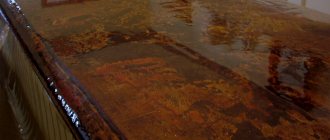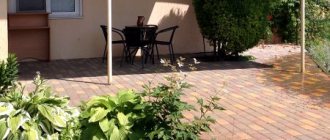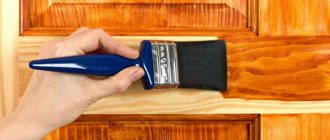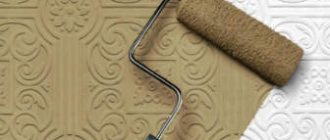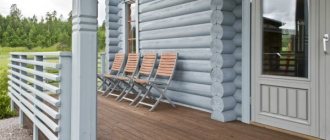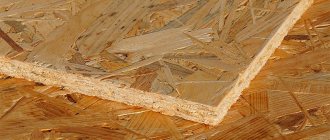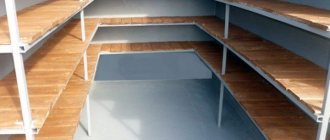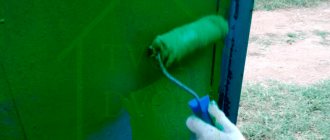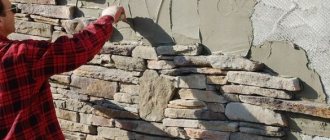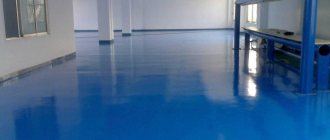Timely painting of outdoor concrete will help protect the durable material from self-destruction. The concrete mixture, when hardened, has a porous structure, so prolonged exposure to a humid environment can be detrimental to reinforced concrete. Structures erected on the street react especially strongly to destructive factors. Special coloring compounds will help protect the structure from destruction, give it an aesthetic appearance and protect it from the negative influence of the environment.
Staining Concrete - Basics
Concrete will be required for construction and production of building materials. The material itself has a number of properties. Qualities:
- strength;
- resistance to mechanical damage;
- an easy way to create elements;
- durability.
When choosing what to paint concrete with, you will need to take into account all the requirements of the material for the coating. An example would be outdoor concrete paint. It must combine durability, attractiveness, as well as resistance to moisture and solar radiation.
Important! There are differences between painting concrete outdoors and indoors that will need to be taken into account when choosing a technology. This is due to the requirement to protect building materials used outdoors, since they are exposed to sunlight, precipitation, and changes in ambient temperature.
Why do this?
Painting concrete is considered a necessary activity. This procedure is carried out for reasons of aesthetics, as well as to protect the surface from negative influences. Reasons for painting a concrete surface:
- dust removal;
- obtaining protection from mechanical damage or wear;
- resistance to chemicals, temperature changes and similar factors;
- extension of service life;
- good view;
- improved performance.
Painted concrete surface will have a set of qualities depending on the type of product. Select materials that meet the necessary criteria. An example is the choice of varnish for the garage floor. It must have a good level of resistance to aggressive substances. The path in the country house or the porch of the house should be treated with varnish that is resistant to water.
The coating improves the interior and protects building materials from damage.
Requirements for compositions
When choosing a suitable composition, you should focus not only on the color of the paint, but also on its characteristics. The purchased paint and varnish material must withstand special operating conditions, and therefore must meet certain requirements.
In order for the applied coating to last as long as possible, it is necessary to choose compositions that have:
- resistance to abrasion and mechanical stress;
- resistance to ultraviolet radiation, which can cause cracking and peeling of the applied coating;
- good breathability;
- sufficient durability. The properties of the applied composition must remain unchanged for many years.
Painting inside and outside, what's the difference?
How to properly paint concrete depends on the requirements for the surface of the material, as well as the location of the work. The difference in painting manifests itself in several conditions:
- What and how to paint concrete. When finishing inside, the layer's resistance to environmental influences will not be required. When painting outdoors, you will need to take into account all the negative factors to which the surface will be exposed.
- Procedure time. Inside, work can be done at any time. Outdoors, the process is only possible in good weather without precipitation.
- Temperature conditions. Concrete in outdoor conditions is painted only at temperatures above 5 degrees.
Take into account that incorrect painting of concrete walls on the outside will lead to deterioration in the quality of the coating.
Important! When working outside, a work plan is drawn up in advance, which eliminates all factors affecting the durability of the coating.
Features of application for outdoor work
Rubber paint for concrete is used in home and industrial construction, repair of buildings and structures. Main areas of its application:
- Facades of residential buildings, industrial buildings, reinforced concrete fences. Thanks to rubber paint, the walls of the building acquire a pleasant color, are moisture and frost resistant, and are not covered with moss, fungi, or dirt. Re-painting of the walls will be required no earlier than 7-8 years after treatment.
- Stationary cast pools. The latex coating will provide waterproofing, a beautiful azure or blue color of its walls and bottom, and a safe descent and exit from the pool for swimmers. You can choose the paint color at your discretion. The moisture-resistant latex layer does not slip. This is especially true for families with children.
- Bicycles, jogging tracks, sports grounds, courts. Rubber floor paint for concrete provides good adhesion of the athlete's shoes to the floor covering on which he is training. This eliminates injuries and falls from slipping sneakers during sports.
- Roofing made of natural tiles, slate, ondulin. Despite the fact that the manufacturer indicates “for concrete” on the packaging, builders successfully use it to protect house roofs from moisture, fungus, and dirt.
Latex paint for concrete is a multifunctional protective and decorative coating.
Which product to choose, types of materials
Not all paints and products are suitable for concrete. It is important to remember that for each procedure a different version of varnish is selected. All types of paint have their own set of qualities and characteristics.
Oil paints
Oil-based paints are used for painting interior and exterior surfaces. The downside is toxicity due to the special composition with solvents. Paint is rarely used in poorly ventilated areas. It is optimal to use it for outdoor work. An example would be painting a concrete fence. Pros:
- low price;
- moisture resistance and resistance to atmospheric factors;
- beautiful coating with a durable base;
- easy cleaning;
- long-term operation;
- good level of adhesion;
- many colors.
Among the disadvantages are a strong odor, long drying time, and a low level of elasticity, which often contributes to the appearance of cracks.
Water based paints
Water-based painting materials have a set of positive aspects that allow craftsmen to use paint for any work. This point also applies to painting indoor walls. Pros:
- environmental friendliness;
- no fear of moisture;
- quick drying;
- no odors;
- easy to use;
- any colors.
The only downside is the price, which is higher than the oil version. The coating does not contain harmful substances, therefore it is recognized as a good method for interior decoration of residential buildings. For exterior work, façade paints are used. Paint characteristics and operating conditions are indicated on the packaging. For outdoor work, wear-resistant varnishes are selected.
Acrylic paint
Acrylic paint is considered a universal product that is used for exterior and interior work. When choosing, pay attention to the purpose of the paint. It may have the characteristics necessary for painting facades, walls, ceilings, as well as for artistic purposes.
Pros:
- the coating is environmentally friendly and safe;
- resistance to mechanical stress;
- elasticity;
- vapor permeability, which allows the coating to breathe without condensation;
- the color does not fade with prolonged use;
- tinting possible;
- moisture resistance and resistance to any type of wear;
- extended service life.
Alkyd compositions differ from similar options not only in their set of advantages, but also in their high cost.
Silicate based paints
Silicate paint is considered a durable material. The basis of the coating is liquid glass, which covers the surface with a film of high strength.
Important! The consumption of each silicate option differs, so when choosing, you will need to read the instructions, which indicate the required numbers.
Pros:
- is not damaged by chemicals and is resistant to their effects;
- stable color range;
- durability due to increased strength;
- moisture resistance and fire safety;
- not susceptible to fungi and mold.
The wear-resistant coating option is used for any surface, but you need to remember that the composition contains a number of toxic substances.
If it is necessary to create an elastic coating, use paints with a rubber base, which makes the texture soft. This eliminates chips, cracks and similar damage.
Impregnations for concrete
The painting process requires a preparatory procedure. To level the layer on the floor or wall, a special impregnation is used. It is made on the basis of acrylics, polyurethane or epoxy resins.
Impregnations differ in their set of characteristics. Examples include transparent options, as well as antiseptics. Pre-impregnation helps reduce paint product consumption and apply an even layer. Concrete will not become dusty or crumble during work, which will affect aesthetics and durability.
Recovery process
Restoring a concrete walkway begins with identifying its defects and acquiring the necessary materials and tools.
From your inventory you may need:
- Building level;
- Washing machine;
- Chisels;
- Boards;
- Wooden stakes;
- Container for preparing the solution;
- Master OK;
- Grater;
- Brush;
- Sackcloth.
Materials you will need:
- Fine sand;
- Cement;
- Putty for external use;
- Metal pipe;
- Portland cement.
Before repairing a concrete path, it is necessary to complete the preparatory stage. This includes not only purchasing the necessary tools and materials, but also cleaning the areas being repaired.
To do this, it is better to use a washing machine with a guide under a certain pressure and a stream of water. This unit makes it easy to remove moss, dirt, loose parts of concrete paths and other elements.
Repairing cracks in the walkway
Advice: If there is severe damage and a large number of small cracks, the coating should be completely changed. And in case of single damage, small cracks are sealed with fresh mortar, which will ensure the durability of the coating for several years of its operation.
Most often, owners of their plots have to seal cracks in concrete paths.
Work instructions:
- Debris, dirt, mold and grass are carefully removed from the cracks;
- For high-quality adhesion of the mortar to the surfaces to be repaired, it is recommended to deepen the potholes to two centimeters, with a slight expansion of the crack;
- A solution is prepared in a prepared container. You can stir it by hand, but it is better to use an electric drill with a special attachment attached;
- For narrow cracks, sand and cement are mixed in a ratio of 3:1;
- A cement-gravel mixture with fine fractions is prepared for wide cracks;
- It is better to lay reinforcement made of large diameter wire into a deep crack.
- Small cracks and holes can be filled with an exterior compound. This can be quick-drying cement or mortar to which sifted fine sand has been added;
Tip: When sealing cracks in concrete, it is worth purchasing a set of a ready-made primer polymer composition for treating the edges of cracks and a dry ready-made mixture, which contains sand, cement and astringent polymer additives.
- The solution is brought to the consistency of sour cream;
- The composition is carefully poured into the crack and carefully leveled over its entire length;
- The mixture is pierced inside with a spatula to ensure that the entire volume is filled with the solution;
- The sealing areas are leveled with a metal trowel or trowel. In this case, you need to ensure that the edges of the cracks do not protrude too much above the surface of the main concrete covering;
- The surface is leveled with a regular brush, in the absence of special power tools. This will help push out the air and roughen the surface, making the areas less slippery;
- To enhance the adhesion of the mixture, it is recommended to apply PVA glue to the surface.
Tip: In hot weather, to prevent the seal from drying out too quickly, you should lay a sackcloth or a rag moistened with water on top of the crack.
Concrete surface repair
Preparing the surface for repair
Restoration of canvas edges
Along with the formation of cracks, pieces of the fabric break off on the side especially often.
The reason for this is usually a missing curb when the concrete was poured. To correct the situation you need to:
- Clean chipped areas;
- Remove all weak areas along the edges of the path;
- Treat surfaces with deep penetration primer. This will strengthen the surface, increase the adhesion of the base and repair mixture;
- Formwork is constructed around the path. It is usually assembled from boards and secured with small wooden stakes;
- All chips are repaired with a solution containing sand, cement and water in a ratio of 3:1:1. Its consistency should be similar to thick sour cream;
Concrete walkway edge defect
- After a day, the formwork is removed.
Construction of formwork around the walkway
Concrete pavement repair
To restore a badly damaged canvas to its original appearance, you must:
- Use a chisel to gouge out loose concrete pieces located on the damaged surface to obtain a solid monolith;
- Clean the canvas thoroughly;
- Prime the surface;
- It is almost always necessary to construct formwork when repairing concrete paths. This will hold the mortar until it has completely hardened;
- The path is filled with cement-sand mortar. Its consistency should be such that it easily fills all the cracks in the canvas, but is not very liquid. The layer of new coating must be at least 30 millimeters thick so that the canvas does not crack again;
- To increase the attractiveness of the path and reduce its slipping, small stones can be placed in the top layer of the coating;
- Before the concrete has completely hardened, it is worth making furrows on its surface with a stiff brush to reduce slipping on the surface in wet weather;
- After a day, the formwork is removed;
- Remove uneven surfaces from the new surface with a grater or burlap.
Many people wonder how to renew a concrete walkway?
If the old pavement on the paths has become worn out and covered with cracks that interfere with safe movement, sometimes it is more advisable to replace it altogether.
An inexpensive replacement is pouring concrete slabs using a silicone mold. Such slabs serve for quite a long time if they are placed correctly, and they look good, which is clearly visible in the photo.
The video in this article will show you how to properly make any repairs to garden paths made of concrete.
Tools, painting equipment, protective equipment
Working with a concrete surface requires a set of tools that differs from analogues for working with stone and tiles. This is due to the need to pre-finish and prepare the concrete for the painting process. Set of tools and tools:
- brushes and rollers, spray gun;
- protective film;
- spatulas and spatulas for applying putty primer;
- protective equipment in the form of a mask and gloves.
When adding pigment, before starting work, you will need to have a mixer, as well as containers for pouring the blind area.
The list of funds depends on the technology of work. For regular painting of an already finished surface, it is enough to have brushes and materials that are selected based on the requirements.
Concrete pavement care
In order for concrete paths and paths in your garden to please you longer, you need to properly care for them with your own hands, following simple recommendations:
- Concrete sheets should be cleaned in winter without the use of salt or any reagents. They will not only destroy the coating, but can also harm plants located in the immediate vicinity of the paths;
- It is necessary to remove weeds that appear on the paths in a timely manner: they can destroy the base of the concrete pavement;
- Do not allow liquid to erode the paths. This can be prevented by installing special grooves along the edges or creating small grooves;
- You should try to keep garden paths clean, which will protect the coating from destruction and help maintain an attractive appearance for a long time.
This is a brief description of how to properly repair a concrete path and how to care for it. But it is always worth keeping in mind, in order not to invest a lot of money when repairing the coating, it is necessary not only to carry out its timely restoration, but also to ensure proper care of the structure.
